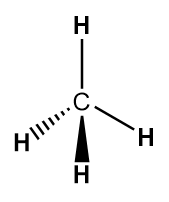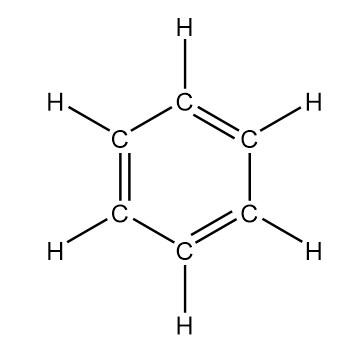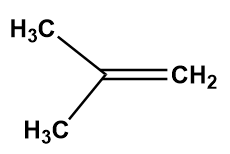
Among the following compounds which are planar in shape.
(a) Methane
(b) Acetylene
(c) Benzene
(d) Isobutene
Answer
222k+ views
Hint: By using the concept of hybridization we can predict the structure of the molecules. The \[s{p^3}\], \[s{p^2}\]and \[s{p^{}}\]hybridization represents tetrahedral, linear, or planar and linear structures respectively. By using the concept of hybridization, we can also predict the electronegativity of an atom.
Complete step by step solution:To determine the hybridization of any given molecule we can use to count the number of sigma bonds:
If the sum of the sigma bond is two, then the hybridization will be \[s{p^{}}\].
If the sum of the sigma bond is three, then the hybridization will be \[s{p^2}\].
If the sum of the sigma bond is four, then the hybridization will be \[s{p^3}\].
If the sum of the sigma bond is five, then the hybridization will be \[s{p^3}d\].
If the sum of the sigma bond is six, then the hybridization will be \[s{p^3}{d^2}\].
(a) Methane (\[C{H_4}\]):
In a methane molecule, the center atom is carbon, and it has four valence electrons. There are four hydrogens attached to carbon atoms which are forming four sigma bonds to the central carbon atom.
Therefore, the sum of sigma bonds will be four. Hence hybridization of the methane (\[C{H_4}\]) will be \[s{p^3}\].
We can also say that the carbon atom of methane possesses one \[s\] and three\[p\]characters. The geometry of the methane molecule will be tetrahedral i.e., it has a non-planar structure.

Image: Structure of the methane molecule.
(b) Acetylene (\[H - C \equiv C - H\]):
The acetylene molecule has two sigma bonds. Therefore, some of the sigma bonds will be two and hence the hybridization of the molecule will be \[sp\].
We can also say that the carbon atom of the acetylene molecule possesses one \[s\] and one\[p\]characters. Therefore, the geometry of acetylene molecules will be linear.
(c) Benzene (\[{C_6}{H_6}\]): The structure of benzene can be described in the following figure.

Image: Structure of benzene.
All the carbon atoms of benzene are the same, and each carbon atom possesses three sigma bonds. Therefore, each carbon atom of benzene has \[s{p^2}\]hybridization with a planar shape.
(d) Isobutene: The structure of isobutene can be represented by the following image.

Image: Structure of the isobutene.
In the structure of isobutene, the central carbon atom has three sigma bonds. Therefore, the hybridization of isobutene will be \[s{p^2}\]and it has a non-planar structure.
Therefore from the above explanation we can say option (c) will be the correct option:
Note: Benzene exists as a colorless liquid at room temperature.
Benzene possesses a sweet odor with a flammable nature.
Benzene can evaporate very fast in the open air.
Benzene is immersible in water because of its non-polar nature.
Complete step by step solution:To determine the hybridization of any given molecule we can use to count the number of sigma bonds:
If the sum of the sigma bond is two, then the hybridization will be \[s{p^{}}\].
If the sum of the sigma bond is three, then the hybridization will be \[s{p^2}\].
If the sum of the sigma bond is four, then the hybridization will be \[s{p^3}\].
If the sum of the sigma bond is five, then the hybridization will be \[s{p^3}d\].
If the sum of the sigma bond is six, then the hybridization will be \[s{p^3}{d^2}\].
(a) Methane (\[C{H_4}\]):
In a methane molecule, the center atom is carbon, and it has four valence electrons. There are four hydrogens attached to carbon atoms which are forming four sigma bonds to the central carbon atom.
Therefore, the sum of sigma bonds will be four. Hence hybridization of the methane (\[C{H_4}\]) will be \[s{p^3}\].
We can also say that the carbon atom of methane possesses one \[s\] and three\[p\]characters. The geometry of the methane molecule will be tetrahedral i.e., it has a non-planar structure.

Image: Structure of the methane molecule.
(b) Acetylene (\[H - C \equiv C - H\]):
The acetylene molecule has two sigma bonds. Therefore, some of the sigma bonds will be two and hence the hybridization of the molecule will be \[sp\].
We can also say that the carbon atom of the acetylene molecule possesses one \[s\] and one\[p\]characters. Therefore, the geometry of acetylene molecules will be linear.
(c) Benzene (\[{C_6}{H_6}\]): The structure of benzene can be described in the following figure.

Image: Structure of benzene.
All the carbon atoms of benzene are the same, and each carbon atom possesses three sigma bonds. Therefore, each carbon atom of benzene has \[s{p^2}\]hybridization with a planar shape.
(d) Isobutene: The structure of isobutene can be represented by the following image.

Image: Structure of the isobutene.
In the structure of isobutene, the central carbon atom has three sigma bonds. Therefore, the hybridization of isobutene will be \[s{p^2}\]and it has a non-planar structure.
Therefore from the above explanation we can say option (c) will be the correct option:
Note: Benzene exists as a colorless liquid at room temperature.
Benzene possesses a sweet odor with a flammable nature.
Benzene can evaporate very fast in the open air.
Benzene is immersible in water because of its non-polar nature.
Recently Updated Pages
Types of Solutions in Chemistry: Explained Simply

States of Matter Chapter For JEE Main Chemistry

Know The Difference Between Fluid And Liquid

Difference Between Crystalline and Amorphous Solid: Table & Examples

Conduction Explained: Definition, Examples & Science for Students

Balancing of Redox Reactions - Important Concepts and Tips for JEE

Trending doubts
JEE Main 2026: Application Form Open, Exam Dates, Syllabus, Eligibility & Question Papers

Derivation of Equation of Trajectory Explained for Students

Hybridisation in Chemistry – Concept, Types & Applications

Understanding the Angle of Deviation in a Prism

How to Convert a Galvanometer into an Ammeter or Voltmeter

Degree of Dissociation: Meaning, Formula, Calculation & Uses

Other Pages
NCERT Solutions For Class 11 Chemistry Chapter 7 Redox Reaction

JEE Advanced Marks vs Ranks 2025: Understanding Category-wise Qualifying Marks and Previous Year Cut-offs

Hydrocarbons Class 11 Chemistry Chapter 9 CBSE Notes - 2025-26

Thermodynamics Class 11 Chemistry Chapter 5 CBSE Notes - 2025-26

NCERT Solutions ForClass 11 Chemistry Chapter Chapter 5 Thermodynamics

Equilibrium Class 11 Chemistry Chapter 6 CBSE Notes - 2025-26




